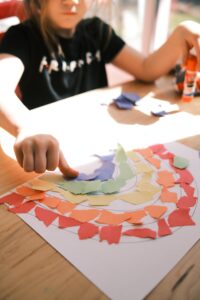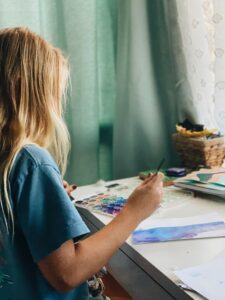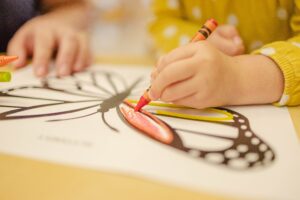A Guide to Introducing the Magic of Meditation and Mindfulness to Children
Creating engaging meditation and mindfulness programs for children is a specialised skill and it can be a highly rewarding and joyous way to offer meditation and mindfulness. In this week’s blog, ACMM Coach, Sammy Wynn is excited to share with you a series of engaging and educational methods that make the beauty of mindfulness and meditation accessible to children. This article is not just a guide for adults to use with children, but also a pathway for us to reconnect with our inner child.
Teachers or those who are interested in working in this space can benefit from specialising in this area as it can be a great way to tap into your inner creativity, learn valuable tips, and ideas, and gain the confidence to customise and create your own age-appropriate offerings that are valuable and fun.
As a meditation and mindfulness teacher who runs much-loved, engaging programs in this space, Sammy shares her top tips and learnings below.
Article Outline:
1. Why Should We Teach Kids to Meditate?
2. The Power of Mindfulness in Children
3. Starting the Meditation Journey with Kids
4. Mindful Activities to Engage Kids
5. Helping Kids Notice and Appreciate the World Around Them
6. Helping Kids Notice Their Emotions Mindfully
7. Integrating Mindfulness Practises through Movement
8. Summary
1. Why Should We Teach Kids to Meditate?
Meditation and mindfulness are practices that can take us far beyond the quiet space on the mat. It can be a practice that supports us to embrace joy, fun and inner exploration through a vast range of techniques.
Meditation for children is not a novel trend, it is a gift of a lifetime that can imbue them with calmness, mindfulness, and emotional resilience. Throughout this article, Sammy lovingly shares various techniques, activities, and approaches that you can adopt to cater to the unique needs and interests of children across all age groups.
2. The Power of Mindfulness in Children
Research tells us that children learn best through play. It’s through tactile, sensory exploration that they can make sense of their world.
“Play captures many of the features that we know from research lead to deeper learning, and thus provides an optimal environment to develop the skills and knowledge that children need to thrive and succeed as adults. Children are intrinsically motivated to play, which makes it fertile ground for learning and developing new skills.”[1]
Therefore, sharing meditation with children requires adapting skills and techniques in a way that allows for play, both guided and self-directed.
3. Starting the Meditation Journey with Kids
Connecting to a sense of joy and play is a beautiful way to share the wonderful world of meditation with children. It allows us the opportunity to connect with our own inner child as we introduce mindfulness skills and practices to children that honour their stage in life, not only developmentally but emotionally.
As a meditation teacher, cultivating this sense of play, while sharing the many benefits of meditation provides a solid foundation from which children can start to learn mindfulness skills for life. It’s rewarding work and all that’s required from you is an open mind, perhaps a gentle shift in perspective and a willingness to allow your own inner child to come out to play.
4. Mindful Activities to Engage Kids

Mindful activities for kids
When working with children it can be helpful to incorporate some additional activities into the class alongside the meditation to ensure that it’s engaging and age-appropriate. As you’ll see in some of the examples below, mindfulness concepts and techniques can be integrated into colouring, painting and further learning experiences, while meditation techniques that allow for movement and physical self-expression are easily adapted for the needs of children.
Children are curious, playful, and open to learning – the perfect combination for a modern-day meditator!
So, here are some simple (and fun!) ways in which you can share meditation and mindfulness with children. You may notice that they focus on some of the key stages of meditation and isolate singular techniques that are easy for children to understand and explore.
5. Helping Kids Notice and Appreciate the World Around Them
As we’ve explored, children learn best through tactile experiences, so what better way to engage them than by connecting to their five senses? Supporting children to connect to their sense of sight, sound, hearing, taste and touch not only supports them to explore their outer world but also fosters a place for them to explore their inner world. Here are some fun ideas for integrating the grounding technique into your classes.
- Grounding Senses Safari
If space allows, set up “senses stations” around the room and then guide the group on a senses safari. You may use sand, water, or nature items for their sense of touch, essential oils for their sense of smell, and with caregiver permission, even some fruit for their sense of taste. The possibilities are endless for the items, sounds, and experiences you can create here.
- Grounding Senses Bingo
If you don’t have the space to move around the room, why not create a 5-senses bingo? Each child receives a senses bingo card and you can name or show items in the class as they mark off their cards until someone calls out, “bingo”. This is a fun, seated activity that can engage all the senses at the start of the class to help them settle into the room.
6. Helping Kids Notice Their Emotions Mindfully
Connecting to the senses lays a wonderful foundation for the introduction of body connection activities. For children, the body connection stage can be about learning what emotions feel like in their bodies and starting to build a vocabulary to communicate those feelings (and associated needs) to primary caregivers.
Colour and movement are wonderful ways to incorporate body connection activities. Here are some fun ideas for this stage:
- What Colour is My Emotion?

Colouring emotions activity for kids
Colour is a wonderful way to explore emotions. In fact, before children learn any language in depth it’s likely they will learn colours first. You’ll notice that most kindergarteners can point to blue or yellow on cue but may not be able to spell it just yet. Colour can provide a pathway for children to express themselves when they don’t yet have the vocabulary to explain their feelings or emotions.
A body scan practice is a great way to introduce and explore emotions and notice how they feel in the body. You may like to guide a body scan practice and ask the children what colour they may be able to feel at their heart, tummy, or feet.
You can offer a follow-up activity to the practice by providing an outline of a body and have the children colour where they noticed these colours in their bodies. You’ll be surprised what naturally is expressed here, so this is an invitation for the children to choose their own colours and self-direct what flows out onto the page rather than being guided on what colours to choose.
- My Inner Animal Body Clue
When exploring inner sensations with children it can be helpful to provide them with age-appropriate examples of what that may feel like for them. Animals can be a great introduction to these concepts and there are endless props and craft activities that can flow on from this theme. For example, you may like to go through a body connection practice with the children, asking them to notice what they feel inside their bodies at their head, back, tummy and feet. They may feel wriggly like a worm, cold like a polar bear, slow like a sloth or flat like a lizard. Once the children explore how they’re feeling you may like to choose one of the animals to guide them into a meditation (for example, being slow like a sloth could lead to a relaxation-based practice).
7. Integrating Mindfulness Practises through Movement
- Dance Meditation
Dance is a wonderful technique to share with children, and it’s also a great way to get all their wriggles out before encouraging some quiet time during the silent surrender stage.
For the dance meditation, you may like to play different types of music, that are lyric-free and that allow for different movements to be expressed. It’s also a great idea to incorporate this music with a sense of play and adventure. For example, you might like to start with a slow song where all the children imagine that they’re slowly floating through the air like a cloud, then introduce an upbeat song, with them all imagining that they are stomping through the jungle like elephants, and ending with a gentle song where they all find their way to lay down or sit down and imagine that they’re being still like a big oak tree.
Not only does movement provide a gentle gateway into stillness, by allowing each child to expend a little energy from their day, it also fosters a space where emotions can be expressed and the individuality of each child can be nurtured.
- Drawing Meditation

Mindful drawing for kids
As shared above, colour is a supportive tool that can be engaged with children and can allow them to express thoughts, feelings, and emotions in instances where they may not yet have a vocabulary to articulate how they’re feeling. Through guided drawing, children can explore their inner landscape in a way that is fun and nurturing.
Drawing meditation provides an engaging and fun avenue for self-expression. Some ideas that you may like to explore are drawing feelings, drawing their safe place, drawing their inner animal, and drawing their day.
You may like to support the children to draw in colours that help them express the feelings associated with what they’re drawing or use colours they feel inspired by that day.
In summary,
- Sharing mindfulness and meditation with children is best when introduced in an age-appropriate and playful way.
- Integrating mindfulness and meditation techniques into activities, crafts, movement, and moments of stillness facilitates the sharing of these important life skills in a way that is developmentally suited to the child.
- Inviting your own inner child out to play can be a helpful way to tap into creative ideas and avenues for further exploration in your teaching.
The ideas, options and pathways are endless. Happy creating, and most of all, happy teaching!
Author – Sammy Wynn, ACMM Coach.
Sammy coaches the core module as well as the Meditation for Parents and Children and Journaling for Clarity electives at ACMM. She holds an Advanced Certificate in Teaching and Guiding Meditation with ACMM, runs her own Integrative Mindfulness Coaching practice and is a member of the Meditation Australia Association.
References
[1] 2017. Lego Foundation. Learning through play: a review of the evidence. Jennifer M. Zosh, Emily J. Hopkins, Hanne Jensen, Claire Liu, Dave Neale,
Kathy Hirsh-Pasek, S. Lynneth Solis and David Whitebread
At ACMM, the Advanced Certificate and Diploma Training Options, include your choice of 3 electives. Elective subjects cover specialist topics such as Meditation for Parents and Children and many more!
Find out if our courses are the right fit for you. Book a Zoom Discovery Call with us today!




